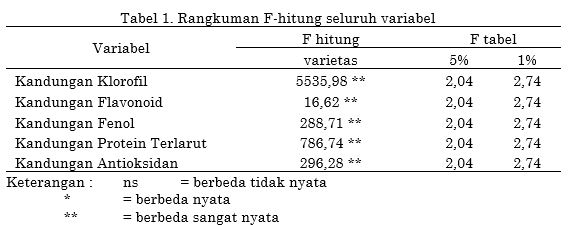Analisis Sifat Fisiologi Dalam Daun Sebagai Bahan Seleksi pada Beberapa Klon Kopi Arabika (Coffea Arabica L.)
Analysis of Physiological Properties in Leaves as Selection Material for Several Clones of Arabica Coffee (Coffea arabica L.)
DOI:
https://doi.org/10.19184/bip.v6i4.35150Keywords:
coffe clones, chlorophyl, flavonoids, phenol, soluble proteinAbstract
The coffee plant (Coffea) is one of the main types of plants in Indonesian society. Coffee plantations in Indonesia are very influential on the national economy. Several types of Arabica coffee clones began to be developed in order to have certain resistance to overcome attacks by various OPT which had a considerable impact on harvest success. The existence of resistance genes in plants, suitability with virulent genes and environmental influences become obstacles in making coffee clones that are resistant to certain pests. The physiological properties of coffee plants will affect the rate of growth and development of plants so that it will have an impact on their production. Selection of plant varieties is carried out to obtain certain superior characters with high yield potential. An analysis of the physiological properties must be carried out to identify and determine the desired selection criteria. This research was conducted at the Laboratory of the Faculty of Agriculture, University of Jember in June – end, using a single factor Completely Randomized Design (CRD), namely several Arabica coffee clones. Arabica coffee clone consists of 15 clones. Each clone was repeated three times, so that in this experiment there were 45 experimental units. Observational data obtained were analyzed using variance. If there is a significant difference between the treatments then proceed with Duncan's multiple range test at the 5% level. Based on the data and discussion of the research that has been done, it can be concluded that the fifteen arabica clones have different characteristics. The best Arabica coffee clone is the Sigararutang coffee clone which has a high value with (76.76 mg/g) chlorophyll content, (4.15 mg/g) flavonoid content, (7.07 mg/g) phenol content, ( 0.89 mg/g) dissolved protein content and (86.94 mg/g) antioxidant content.
Keywords: Coffee clones, chlorophyll, flavonoids, phenols, soluble proteins, antioxidants
Downloads
References
Acidri, R., Sawai, Y., Sugimoto, Y., Handa, T., Sasagawa, D., Masunaga, T. & Nishihara, E. (2020). Phytochemical profile and antioxidant capacity of coffee plant organs compared to green and roasted coffee beans. Antioxidants, 9(2), 93.
Alnopri., Prasetyo dan B. Hermawan. 2011. Ideotipe Kopi Arabika Tanaman Belum Menghasilkan pada Lingkungan Dataran Rendah dan Menengah. Agrovigor, 4(2) : 62-69.
Berlian, Z., Aini, F., & Lestari, W. (2016). Aktivitas antifungi ekstrak daun kemangi (Ocimum americanum L.) terhadap fungi Fusarium oxysporum Schlecht. Jurnal Biota, 2(1), 99-105.
Bertrand, C., Noirot, M., Doulbeau, S., de Kochko, A., Hamon, S., & Campa, C. (2003). Chlorogenic acid content swap during fruit maturation in Coffea pseudozanguebariae: Qualitative comparison with leaves. Plant Science, 165(6), 1355-1361.
Campa, C., Urban, L., Mondolot, L., Fabre, D., Roques, S., Lizzi, Y., ... & Etienne, H. (2017). Juvenile coffee leaves acclimated to low light are unable to cope with a moderate light increase. Frontiers in plant science, 8, 1126.
Chen, X. M., Ma, Z., & Kitts, D. D. (2018). Effects of processing method and age of leaves on phytochemical profiles and bioactivity of coffee leaves. Food chemistry, 249, 143-153.
Chen, X., Kitts, D. D., Ji, D., & Ding, J. (2019). Free radical scavenging activities of phytochemical mixtures and aqueous methanolic extracts recovered from processed coffee leaves. International Journal of Food Science & Technology, 54(10), 2872-2879.
El Senousy, A. S., Farag, M. A., Al-Mahdy, D. A., & Wessjohann, L. A. (2014). Developmental changes in leaf phenolics composition from three artichoke cvs.(Cynara scolymus) as determined via UHPLC–MS and chemometrics. Phytochemistry, 108, 67-76.
Hasanah, M. B, Maharani. E, Munarsih. 2017. Daya Antioksidan Ekstrak dan Fraksi Daun Kopi Robusta (Coffea Robusta) Terhadap Pereaksi Dpph (2,2-Difenil-1-Pikrilhidrazil). IJPST, 4(2): 42-49.
Hulupi, R., dan E. Martini. 2013. Budidaya dan Pemeliharaan Tanaman Kopi di Kebun Campur. Word Agroforestry Centre (ICRAF): Bogor.
Made, N. P. 2012. Evaluasi Galur Jagung SMB-5 Hasil Seleksi Massa Varietas Lokal Bali “BERTE†Pada Daerah Kering. Jurnal Bumi Lestari, 1(12) : 106-115.
Martauli, E. D. 2018. Analisis Produksi Kopi di Indonesia. Agribusiness Sciences, 1(2) : 112-120.
Mawardi, S., Geographic Coffee from Indonesia and its Potential to Support World Espresso Coffee Industry. 2008. 39th International Coffee Day Conference, Trieste: Italy.
Musaffa, M. (2021). Analisis Kandungan Klorofil Pada Tingkat Perkembangan Daun Kopi Robusta (Coffea canephora). Jurnal AGROPLAN. 1(4) : 1-10.
Patay, É. B., Sali, N., Kőszegi, T., Csepregi, R., Balázs, V. L., Németh, T. S., ... & Papp, N. (2016). Antioxidant potential, tannin and polyphenol contents of seed and pericarp of three Coffea species. Asian Pacific Journal of Tropical Medicine, 9(4), 366-371.
Pristiana, D. Y., S. Susanti dan Nurwantoro. 2017. Anitoksidan dan Kadar Fenol Berbagai Ekstrak Daun Kopi (Coffea sp.) : Potensi Aplikasi Bahan Alami untuk Fortifikasi Pangan. Aplikasi Teknoligi Pangan, 6(7) : 89-92.
Rahardjo dan Pudji. 2017. Panduan Budidaya dan Pengolahan Kopi Arabika dan Robusta. Penebar Swadaya: Jakarta.
Rahardjo, P. 2012. Panduan Budidaya dan Pengelolahan Kopi Arabika dan Robusta. Penebar Swadaya: Jakarta.
Raharjeng, A. R. P. (2015). Pengaruh faktor abiotik terhadap hubungan kekerabatan tanaman Sansevieria trifasciata L. Jurnal Biota, 1(1), 33-41.
Ratanamarno, S., & Surbkar, S. (2017). Caffeine and catechins in fresh coffee leaf (Coffea arabica) and coffee leaf tea. Maejo International Journal of Science and Technology, 11(3), 211.
Ritchie, R. J. 2006. Consistent Sets of Spectrophotometric Chlorophyll Equations for Acetone, Methanol and Ethanol Solvents. Photosynth. Res., 89(1):27-41.
Sarjana, I. D. G. R., D. P. Darmawan dan N. W. S. Astiti. 2017. Menurut Potensi Kopi Arabika sebagai Pengusung Komoditas Ekspor Provinsi Bali. Manajemen Agribisnis, 5(1) : 103-110.
Shebis, Y., Iluz, D., Kinel-Tahan, Y., Dubinsky, Z., & Yehoshua, Y. (2013). Natural antioxidants: function and sources. Food and Nutrition Sciences, 6(4) : 1-7.
Sobari, L. Sakiroh dan E. H. purwanto. 2012. Pengaruh Jenis Tanaman Penaung Terhadap Pertumbuhan dan Persentase Tanaman Berbuah Pada Kopi Arabika Varietas Kartika 1. Ristri, 3(3): 217-222.
Subroto, G., Kusbianto, D. E., Avivi, S., Slameto, S., & Setiyono, S. (2019). Correlation of secondary metabolites of leaf with resistance to Leaf Rust (Hemileia vastatrix) on several Arabica coffee clones. Agricultural Science, 2(4) : 71-75.
Suherman., S. Millang dan L, Asrul. 2016. Respon Morfofisiologi, Fenologi, dan Produksi Tanaman Kopi Terhadap Berbagai Naungan dalam Sistem Agroforestri di Kabupaten Enrekang. Sains dan Teknologi, 16(2): 197-202.
Urban, L., Léchaudel, M., & Lu, P. (2004). Effect of fruit load and girdling on leaf photosynthesis in Mangifera indica L. Journal of Experimental Botany, 55(405), 2075-2085.
Utomo, D. S., Kristiani, E. B. E., & Mahardika, A. (2020). Pengaruh Lokasi Tumbuh Terhadap Kadar Flavonoid, Fenolik, Klorofil, Karotenoid Dan Aktivitas Antioksidan Pada Tumbuhan Pecut Kuda (Stachytarpheta Jamaicensis). Bioma: Berkala Ilmiah Biologi, 22(2), 143-149.
Wijayanti, K. S., Rahardjo, B. T., & Himawan, T. (2017). Pengaruh rizobakteri dalam meningkatkan kandungan asam salisilat dan total fenol tanaman terhadap penekanan nematoda puru akar. Buletin Tanaman Tembakau, Serat & Minyak Industri, 9(2) : 54-63.
Xue, Z., Ceng Wang., Lijuan Zhai., Wancong Yu., Hairu Chang., Xiaohong Kou., & Fengjuang Zhou. (2016). Bioactive Compounds and Antioxidant Activity of Mung Bean (Vigna radiata L.), Soybean (Glycine max L.) and Black Bean (Phaseolus vulgaris L.) during the Germination Process. Food Technology and Economy, Engineering and Physical Properties, 34(1) : 68-78.

Downloads
Published
Issue
Section
License
Authors who publish with this journal agree to the following terms:
1.Authors retain copyright and grant the journal right of first publication with the work simultaneously licensed under a Creative Commons Attribution-NonCommercial 4.0 International License that allows others to share the work with an acknowledgement of the work's authorship and initial publication in this journal.
2.Authors are able to enter into separate, additional contractual arrangements for the non-exclusive distribution of the journal's published version of the work (e.g., post it to an institutional repository or publish it in a book), with an acknowledgement of its initial publication in this journal.
3.Authors are permitted and encouraged to post their work online (e.g., in institutional repositories or on their website) prior to and during the submission process, as it can lead to productive exchanges, as well as earlier and greater citation of published work (See The Effect of Open Access).



















